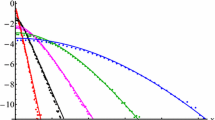Abstract
Solvent components that prevent reagent diffusion lead to a proportion of particles that do not react, which affects the decay in the reagent concentrations. The A+ B→B reaction occurring in a one-dimensional system may be accelerated or retarded in accordance with the solvent concentration. Experiments are indicated in which it is predicted that one can observe effects from fluctuations in the concentrations of the B particles and solvent components.
Similar content being viewed by others
Literature cited
B. Ya. Balagurov and V. G. Vaks, “Random walks over a lattice containing traps,” Zh. éksp. Teor. Fiz.,65, No. 5, 1939–1946 (1973).
Ya. B. Zel'dovich and A. A. Ovchinnikov, “The law of mass action and reaction kinetics incorporating thermodynamic density fluctuations,” ibid.,74, No. 5, 1588–1598 (1978).
A. A. Ovchinnikov and Ya. B. Zeldovich, “Role of density fluctuations in bimolecular reaction kinetics,” Chem. Phys.,28, No. 1/2, 215–218 (1978).
S. F. Burlatskii, “Effects of reagent inhomogeneity on bimolecular recombination kinetics,” Teor. éksp. Khim.,14, No. 4, 483–487 (1978).
E. A. Kotomin and V. N. Kuzovkov, “Some problems in recombination kinetics. Part 1,” Chem. Phys.,76, No. 4, 479–487 (1983).
K. Kang and S. Redner, “Fluctuation-dominated kinetics in diffusion-controlled reactions,” Phys. Rev. A,32, No. 1, 435–447 (1985).
G. Zumofen, A. Blumen, and J. Klafter, “Concentration fluctuations in reaction kinetics,” J. Chem. Phys.,82, No. 7, 3198–3206 (1985).
L. I. Gal'chuk and A. I. Onipko, “Jump excitation-energy transport in a molecular chain having a random trap distribution,” Ukr. Fiz. Zh.,32, No. 7, 1005–1012 (1987).
J. K. Anlauf, “Asymptotically exact solution of the one-dimensional trapping problem,” Phys. Rev. Lett.,52, No. 21, 1845–1848 (1984).
L. I. Gal'chuk and A. I. Onipko, “The kinetics of A+B→B bimolecular reactions in one dimension,” Khim. Fiz.,6, No. 6, 825–830 (1987).
A. I. Onipko, “Application of the cluster size distribution in binary randomly disordered finite chains,” Phys. Status Solidi b,123, No. 1, 37–44 (1984).
A. I. Onipko, Cluster Length Distribution in a Limited Randomly Disordered Chain and Exactly Solvable Models of One-Dimensional Discovered Systems, Kiev (1986). (Preprint No. 58E, Acad. Sci. Ukr. SSR, Inst. Theor. Physics.)
D. D. Dlott, M. D. Fayer, and R. D. Weiting, “Effects of impurity scattering and transport topology on exciton migration and trapping: an experimental study of quasi-one-dimensional molecular crystals,” J. Chem. Phys.,69, No. 6, 2752–2762 (1978).
R. M. Hochstrasser and J. D. Whiteman, “Exciton band structure and properties of a real linear chain in a molecular crystal,” ibid.,56, No. 12, 5945–5958 (1972).
V. A. Karachevtsev, “Triplet excitons in a quasi-one-dimensional crystal formed by a charge-transfer complex between naphthalene and tetrachlorophthalic anhydride,” Fiz. Tverd. Tela,28, no. 5, 1400–1406 (1986).
Author information
Authors and Affiliations
Additional information
Translated from Teoreticheskaya i éksperimental'nana Khimiya, Vol. 24, No. 1, pp. 8–13, January–February, 1988.
Rights and permissions
About this article
Cite this article
Onipko, A.I. Diffusing-particle trapping kinetics for a one-dimensional solution. Theor Exp Chem 24, 7–11 (1988). https://doi.org/10.1007/BF01392183
Received:
Issue Date:
DOI: https://doi.org/10.1007/BF01392183




